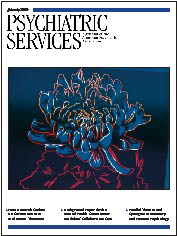Psychiatric Nurse Practitioners in Rural Pediatric Telepsychiatry
In 2001 the U.S. Surgeon General's action plan agenda identified a critical need for mental health care for American youths. The report delineated the perpetual shortage of psychiatric specialists, especially in rural areas, that showed no signs of improving.
Children with psychiatric disorders in rural upstate New York, as in other regions of the country, have been chronically underserved, and rural mental health clinics are rarely able to recruit child psychiatrists. Nurse practitioners who pursue advanced specialty training and experience can acquire state specialty certification in psychiatry and in pediatric psychiatry. However, regulations require a collaborative agreement between the nurse practitioner and a child psychiatrist that ensures regular clinical collaboration between the parties.
The concept of a program for youths in rural, underserved areas of New York State through a regular, collaborative teleconference between nurse practitioners and a child psychiatrist based at the Upstate Medical University Syracuse was developed three years ago as a response to the growing need for child mental health services in rural regions. The primary barriers to developing the program were determining the appropriate level of technology (televideo or telephone), acquiring funding, and fine-tuning the contract between the county clinic, the university hospital, and the child psychiatrist.
These issues were relatively easily overcome. Telephone conferencing was readily and immediately available and inexpensive; funding, from the county clinic perspective, was easily justified because a weekly hour with the child psychiatrist and nurse practitioner was substantially less expensive than recruiting a full- or part-time child psychiatrist (even if it was possible), and the contract was crafted by the attorneys for the parties within three months.
Weekly (biweekly for the part-time nurse practitioner) collaborative clinically focused discussions between the child psychiatrist and the nurse practitioner have been ongoing. A total of 200 individual cases have been presented and discussed in the three years since the program began, almost half of which have involved follow-up collaboration. Three nurse practitioners are involved in the program, in two different rural counties. The nurse practitioners have learned to present a succinct case history of individual patients, followed by problem-focused discussions. Recommendations for improved assessment, diagnosis, record-keeping, collaboration with therapists and schools, and pharmacologic management have been implemented. A semistructured interview format and the use of specific rating instruments, including the Child Behavior Checklist, the Conner's Behavior Rating Scale, the Children's Depression Inventory, and the Multidimensional Anxiety Scale for Children, are now used routinely.
The nurse practitioners have gradually modified their style and approach to evaluation and treatment in response to regular mentoring. The patient profiles of the children and adolescents whom the nurse practitioners treat are often very complex and challenging, even to the child psychiatrist collaborator. These children are in desperate need of many services, including psychiatric care, and are often at extreme risk of deteriorating on a daily basis. Many patients come from dysfunctional families in which parents may be separated, divorced, incarcerated, or abusing drugs. Many have experienced violence, poverty, mental illness, multiple moves, foster placements, school failure, psychiatric hospitalization, residential placement, and numerous medication trials. Difficult and demanding consumers, frequent no-shows, abrupt out-of-county moves, acute decompensation, noncompliance with medications, noncompliance with laboratory testing and general medical care, and unrealistic expectations of medications are just some of the challenges facing the clinicians who work with this client population.
The clinic director has periodically interviewed the nurse practitioners to ascertain their level of satisfaction with the program. They have consistently responded positively, stating that the regular and systematic telephone contact has been an excellent source of useful clinical information and an indispensable component of care. Although the director has stated that the program will continue unchanged, a proposed outcome-based assessment in comparable rural clinics with and without child telepsychiatry could assist in budget and program development.
Dr. Staller is assistant professor in the division of child and adolescent psychiatry at the State University of New York Upstate Medical University, Syracuse, New York 13210 (e-mail, [email protected]).



